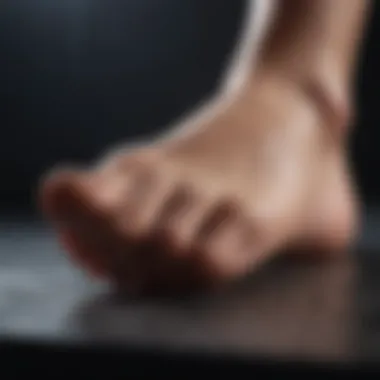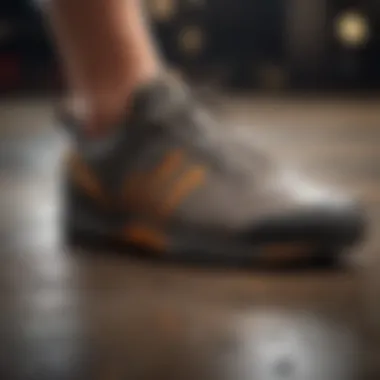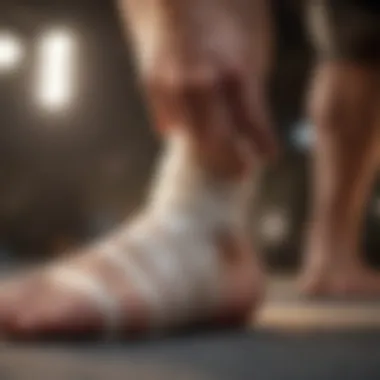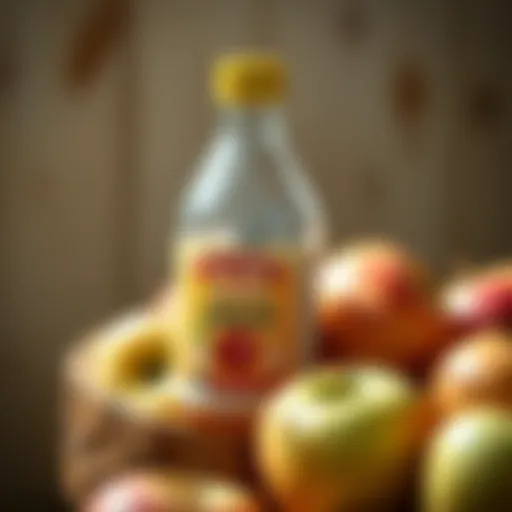Quick Strategies to Heal Foot Blisters Effectively


Intro
Blisters on the feet are a common affliction, particularly among those who lead active lives. They form due to friction, moisture, or other irritation on the skin. This uncomfortable condition can bring about not only physical pain but also hinder one's mobility and enjoyment of activities. Understanding the anatomy of a blister and the methods to treat them effectively is essential for a quick recovery.
In this article, we will delve into key benefits, preventive strategies, and treatment options that allow for rapid healing of foot blisters. By equipping oneself with the right knowledge and methods, individuals can learn to address this issue promptly.
Key Benefits
Physical Health Benefits
Addressing foot blisters swiftly can significantly improve one’s physical health. Speedy recovery means returning to regular activities without prolonged pain or discomfort. When foot blisters are left untreated, they can lead to infections or complications that further delay healing.
- Enhancing mobility: Quick management of blisters allows individuals to engage in their desired daily activities sooner.
- Reduced pain levels: Efficient treatment can minimize pain and discomfort that often accompany foot blisters.
- Prevention of infection: Proper care and timely intervention reduce the risk of bacterial or fungal infections that can arise from untreated blisters.
Mental Well-being Enhancements
The effects of physical discomfort often ripple into mental health. Chronic pain can lead to irritability, anxiety, or reduced quality of life. Thus, managing foot blisters not only alleviates physical symptoms but also contributes positively to mental well-being.
- Improved mood: Once pain subsides, individuals can experience an uplift in their general mood.
- Lower stress levels: Quick recovery from foot blisters can reduce the stress of dealing with discomfort during daily tasks.
- Enhanced focus: With blisters healing, mental energy can be redirected to pursuits beyond managing pain or discomfort.
"A blister is a body's way of signaling a problem. Addressing it promptly can have lasting positive effects."
Practical Tips
Effective Care Techniques
To expedite healing, one must implement effective care techniques. Some basic steps include:
- Keep the area clean and dry: Wash with mild soap and dry gently.
- Protect the blister: Use sterile bandages or blister pads to shield the area from further irritation.
- Avoid popping the blister: This can lead to infection and slow the healing process.
- Hydration and nutrition: Ensure proper hydration and consume a balanced diet to support skin healing.
Treatment Options
There are various treatment options available to aid recovery:
- Over-the-counter creams: Products containing zinc oxide can soothe and promote healing.
- Natural remedies: Aloe vera gel can be beneficial with its anti-inflammatory properties.
- Consultation with a healthcare professional: In severe cases, seeing a doctor may be necessary.
By understanding and implementing these strategies, individuals can significantly reduce the discomfort associated with foot blisters, allowing for a swift return to everyday activities.
Understanding Blisters
Blisters on the feet often signify an underlying problem that, if not addressed, can lead to prolonged discomfort. Understanding blisters is crucial in effectively healing them. This section will explore what blisters are, their types, and the common causes associated with foot blisters. Knowledge of these aspects helps in selecting appropriate treatments and preventive measures.
Definition of Blisters
Blisters are small pockets of fluid that form between the layers of skin. Generally, blisters fill with clear fluid and may appear swollen. They can serve as a protective barrier to damaged skin underneath. Understanding this definition sets the stage for recognizing how best to care for the affected area.
Types of Blisters
Blisters can be categorized based on their causes. For instance, friction blisters often arise from repetitive movements, burn blisters from thermal injury, and cold sores, which are viral in nature, sometimes appear on the feet. Each type requires a different approach to care, influencing healing speed and effectiveness.
Friction Blisters
Friction blisters result from repeated rubbing of the skin against a surface. This common issue often affects the feet during physical activity, especially if shoes do not fit well. A key characteristic is that they may not always be filled with fluid initially.
They present a challenge in daily activities, and knowing their specifics allows individuals to implement immediate care actions before they worsen.
Burn Blisters
Burn blisters occur from exposure to heat or chemicals. These blisters represent the skin’s natural response to injury as it seeks to protect deeper tissues. Though less common than friction blisters, they carry significant implications. They can become infected easily, making medical attention essential. Understanding the proper care for burn blisters is vital, especially in preventing complications.
Cold Sores
Cold sores are caused by the herpes simplex virus and are typically associated with oral regions. However, it's essential to note they can also manifest in unusual locations including the feet. Their reoccurring nature poses a challenge, and understanding this helps individuals manage and prevent outbreaks effectively.
Causes of Blisters on Feet
Causes of blisters vary widely and knowing them informs treatment decisions. This section identifies some of the primary causes of blisters on feet, which include ill-fitting footwear, excessive moisture, and prolonged activity.
Ill-Fitting Footwear
Ill-fitting footwear is arguably the most frequent contributor to blisters. Shoes that are too tight or too loose can lead to increased friction. Understanding this characteristic allows individuals to prioritize shoe selection as part of their care routine.
Proper footwear can contribute significantly to reducing the occurrence of blisters.
Excessive Moisture
Excessive moisture on the feet creates an environment conducive to blister formation. Sweaty feet or damp socks can weaken the skin and facilitate friction. Knowing this helps individuals in selecting breathable materials to keep feet dry, thereby reducing the likelihood of blister development.
Prolonged Activity
Prolonged activity puts excessive strain on the feet, leading to blisters due to repetitive movements. This factor makes it essential for individuals engaged in physical activities to assess their habits thoroughly. Planning regular breaks or alternating intense activities can help mitigate blister formation during prolonged physical exertion.


Symptoms and Diagnosis
Understanding the symptoms and diagnosis of blisters is crucial in managing foot blisters effectively. When you can identify the signs early, you can begin appropriate treatment and prevent further complications. Recognizing symptoms such as redness, fluid accumulation, and pain is essential for effective blister care and expedites the healing process. Knowing when to seek medical help is equally important in certain situations, especially if the blister may lead to infection or if it is particularly painful.
Identifying Blister Symptoms
Redness and Inflammation
Redness and inflammation around a blister indicate an area that is reacting to irritation or injury. The skin becomes inflamed as part of the body's natural healing response. This is a key characteristic of blisters and is beneficial because it alerts you to the injury. Without recognition of this symptom, individuals may overlook the need for proper care. One unique aspect of redness and inflammation is that it can signal the need for immediate attention if it worsens, as this may indicate complications such as infection.
Fluid Accumulation
Fluid accumulation within the blister serves to protect the underlying skin as it heals. It acts as a cushion from further friction. Recognizing this can help you assess the blister's severity. Fluid-filled blisters are common and usually heal without intervention. However, if the fluid becomes cloudy or discolored, this represents a potential risk for infection. Therefore, monitoring fluid accumulation is important for understanding your blister's health.
Pain and Tenderness
Pain and tenderness are significant indicators of the severity of a blister. When a blister forms, the surrounding area can become sensitive, making movement uncomfortable. This symptom is a direct cue that something requires attention. Pain serves as a reminder to care for the blister and avoid activities that could exacerbate it. It is essential to gauge the level of discomfort, as persistent pain may warrant medical evaluation.
When to Seek Medical Attention
In some cases, the management of blisters cannot be handled at home. Knowing when to consult a healthcare professional can be lifesaving.
Signs of Infection
Identifying signs of infection such as increased redness, warmth, swelling, or pus is critical. If any of these symptoms arise, it’s essential to seek medical attention. This is a key characteristic because untreated infections can lead to more serious health complications. Timely intervention can make a significant difference in treatment and recovery.
Persistent Pain
If pain does not subside within a few days or worsens with time, it could be a sign of an underlying problem. Persistent pain is not only uncomfortable but may indicate complications. This unique feature emphasizes the need for careful monitoring and an understanding of normal healing processes. If pain persists, consulting a professional can help determine the best course of treatment.
Severe Blistering
Severe blistering, particularly if it is extensive and occurs in clusters, may indicate a more serious condition such as a skin disease or an allergic reaction. It’s important to recognize that severe blistering could signal that the body is responding to a significant internal issue. This characteristic makes it imperative that one do not shrug off the severity. Seeking immediate medical care can prevent further complications and aid in appropriate management.
Immediate First Aid for Blisters
Addressing blisters quickly can significantly influence the healing process. Immediate first aid is key to minimize pain and prevent potential infection. Blisters can quickly become a hindrance, especially for active individuals. Prompt care not only provides relief but can help in faster recovery, enabling a quicker return to daily activities. Therefore, understanding the correct initial steps is essential.
Initial Care Steps
Cleaning the Area
Cleaning the area around the blister is a critical step. This action removes dirt and bacteria, thus significantly reducing the risk of infection. Mild soap and water work effectively for this task. The key characteristic of this step is its simplicity and accessibility. It is a beneficial choice for anyone dealing with blisters. The unique feature of cleaning is that it sets the foundation for the subsequent care, promoting better healing. One disadvantage is that if done improperly, the area might become irritated, which can worsen the situation.
Avoiding Popping the Blister
Avoiding the temptation to pop the blister is important for overall healing. Keeping the blister intact helps protect underlying skin. The main advantage of this approach is that the blister forms a natural barrier against infection. This practice is popular in first aid and is often recommended by health professionals. Some might argue that draining can relieve discomfort; however, popping a blister often leads to prolonged healing time and increased risk of complications. Therefore, it is wise to adhere to this guideline.
Applying a Sterile Dressing
Applying a sterile dressing helps to protect the blister from further irritation. This protects it while also providing an additional layer of hygiene. The key characteristic of this action is its protective nature. Using a sterile dressing is an essential step in preventing infection and manages discomfort caused by friction. The unique feature of this type of dressing is its ability to create a moist environment, which is beneficial for healing. However, if the dressing is not kept clean or changed regularly, it can lead to complications.
Pain Management Techniques
Ice Application
Applying ice can help reduce swelling and numb pain. This technique is beneficial for providing immediate relief after the formation of a blister. Ice is easily accessible and does not require prescriptions, which makes it a popular choice for pain management. The main advantage is its cooling effect, which can ease discomfort. However, care should be taken to ensure that ice is not applied directly to the skin to avoid frostbite.
Over-the-Counter Pain Relief
Over-the-counter pain relief options, like ibuprofen or acetaminophen, can help manage discomfort effectively. These medications are known for their fast action, providing relief when applied correctly. Their widespread availability makes them a popular choice for many. The unique characteristic is that they are easy to use and provide consistent results. However, reliance on these medications should be moderated and monitored, as overuse can lead to potential side effects.
Elevation of Feet
Elevation of the feet can reduce swelling and promote circulation, which can enhance healing. It is a simple and effective method that requires minimal effort. By elevating your feet, you can improve blood flow to the area, contributing to quicker recovery. Be aware, though; prolonged elevation can lead to discomfort if maintained for too long. Thus, balance is key when practicing this technique.
Dressing and Protection for Blisters
Dressing and protecting blisters on your feet is vital for ensuring healing while preventing further irritation. Proper dressing serves to protect the blister from friction and environmental contaminants. Furthermore, it can help manage pain and accelerate recovery. Using suitable protection allows for better mobility, keeping daily activities less affected by the blister. A key element here is understanding the options for both dressing and protective strategies.
Choosing the Right Dressing
Choosing the right dressing is an important step in healing foot blisters effectively. Each type of dressing serves unique purposes, catering to various blister severities and locations.
Hydrocolloid Bandages
Hydrocolloid bandages are a popular mix of moisture-retentive and adhesive materials. Their key characteristic is the ability to provide a moist environment conducive to healing. This feature allows tissue to regenerate while minimizing pain. Hydrocolloid bandages also create a barrier against bacteria, significantly reducing infection risks. However, they can be more expensive than traditional options. Some users might find the texture uncomfortable at first, but the benefits often outweigh these concerns.


Adhesive Pads
Adhesive pads are another option, offering simple and effective protection. Their main characteristic is that they stick well to the skin and provide a cushion over the blister. They typically have a soft inner lining that absorbs some moisture. This makes adhesive pads a beneficial choice for less severe blisters. They are affordable and readily available. However, frequent changing may be necessary to maintain effectiveness, as they can lose adhesion when wet.
Gauze and Tape
Gauze and tape are classic choices for dressing blisters. Their primary feature is flexibility; they can cover large areas or be cut to fit specific blisters. This choice is beneficial for multiple injured areas, as individuals can customize coverage as needed. However, gauze allows air circulation, which might hinder healing compared to occlusive dressings. Frequent changes are also required to keep the area clean and dry.
Protective Footwear Strategies
Using effective protective footwear strategies is essential for minimizing the risk of additional blisters forming. These strategies focus on selecting the right materials and ensuring appropriate fit for the feet.
Selecting Breathable Materials
Selecting breathable materials for footwear offers improved comfort and reduced moisture. Breathable materials allow air circulation, helping to keep the feet dry throughout the day. This can lower the likelihood of blisters forming during prolonged activities. Shoes made from mesh or lighter fabrics can significantly enhance airflow. On the downside, these materials might compromise support. It's crucial to find a balance, ensuring that breathability does not come at the expense of stability.
Choosing Proper Fit
Choosing proper fit is an essential consideration when selecting footwear. Shoes that fit well do not rub against the skin, thereby reducing friction and blister formation. Proper fitting helps distribute pressure evenly across the foot. Additionally, a good fit allows for some wiggle room but should still feel secure. Ill-fitting shoes can cause a host of problems, making it imperative to test shoes before committing. The downside is that finding the right size can be a time-consuming process, particularly for individuals with wide or narrow feet.
Avoiding High-Impact Activities
Avoiding high-impact activities is crucial during the blister healing process. High-impact activities, such as running or jumping, can irritate an already sensitive area. Reducing impact gives the blister a chance to heal faster, enabling a return to normal activities sooner. This step is particularly beneficial when blisters develop from intense training or prolonged standing. However, this limitation can be frustrating for active individuals. Finding low-impact alternatives is often necessary during this healing period.
"Understanding the correct dressings and strategies for footwear can greatly improve the healing process for foot blisters."
By being informed about the options available, individuals can make better choices that align with their needs.
Home Remedies for Accelerated Healing
Home remedies can play a significant role in the healing process of blisters on the feet. Utilizing natural ingredients offers several benefits, including accessibility, cost-effectiveness, and reduced risk of side effects compared to pharmaceutical options. Many people prefer home remedies as they often incorporate items commonly found at home, making them an excellent first line of treatment.
The focus of home remedies is often on soothing the pain and encouraging the body's natural healing processes. In many cases, these remedies harness the properties of specific compounds that promote skin health, reduce inflammation, or provide moisture. It is important to remember that while home remedies can be effective, they might not replace professional medical advice, especially if symptoms persist.
Natural Healing Agents
Aloe Vera
Aloe vera is a popular home remedy known for its soothing and moisturizing properties. When applied to blisters, it can help reduce swelling and speed up healing. The gel-like substance contains enzymes and antioxidants that are beneficial for skin repair. Not only does it hydrate the skin, but it also has anti-inflammatory effects that can alleviate discomfort and redness.
A unique feature of aloe vera is its ability to penetrate deep into the skin layers, promoting optimal healing conditions. It is generally safe for topical use but may cause allergic reactions in some individuals, so a patch test is advisable before widespread application.
Tea Tree Oil
Tea tree oil is renowned for its antiseptic and antibacterial properties. It is effective against infections that could develop around blisters. When diluted with a carrier oil, tea tree oil can be applied gently to the blister site. Its key characteristic lies in its ability to prevent infections, ensuring that the blister area remains clean.
However, tea tree oil must always be used cautiously as it can cause irritation if applied directly. The advantage of using tea tree oil is its natural antibacterial action, but it is worth noting that overuse can lead to skin dryness.
Chamomile Compresses
Chamomile compresses are known for their calming effects and their ability to reduce inflammation. When soaked in chamomile tea, a cloth can be applied to the blister area to soothe the skin. The key characteristic of chamomile is its anti-inflammatory and antispasmodic effects, which can help relieve pain and redness.
Using chamomile is generally safe and beneficial; it can also promote relaxation. However, some people may have allergies to chamomile, so caution is necessary. Overall, chamomile compresses serve as a natural way to support the healing process while providing comfort.
Hydration and Nutrition
Importance of Hydration
Staying hydrated is crucial for overall health, and it significantly impacts the healing of blisters. Adequate water intake aids in maintaining skin elasticity and promotes cellular functions. Hydration ensures that the body has the necessary resources to recover from injuries such as blisters.
The unique aspect of hydration is that it helps to flush out toxins, preventing complications that may arise from infections. While drinking water is essential, hydration can also come from consuming fruits and vegetables with high water content. Dehydration can slow healing, making this a vital point in the recovery process.
Nourishing Foods for Recovery
A balanced diet rich in nutrients plays an important role in healing blisters. Foods high in protein, such as chicken, fish, beans, and legumes, are essential for tissue repair. Additionally, incorporating fruits and vegetables high in vitamins and antioxidants can help bolster the immune system.
Unique to this discussion is the preference for whole foods over processed options. Whole foods provide necessary micronutrients essential for recovery, such as vitamins A and C, zinc, and omega-3 fatty acids. These nutrients not only assist in healing but also improve overall skin health.
Vitamins and Minerals
Vitamins and minerals are essential for wound healing and skin health. Vitamin C is known for its role in collagen production, which helps to regenerate tissue. Zinc plays a critical role in immune function and skin repair, while Vitamin E offers antioxidant properties that protect skin cells from damage.
Highlighting specific vitamins can encourage individuals to prioritize their dietary choices for faster recovery. Supplements can be beneficial, but obtaining these nutrients from food sources is ideal. This natural approach tends to be better absorbed and utilized by the body.
Maintaining a nutrient-rich diet can significantly impact the speed at which blisters heal and overall foot health.
Preventing Blisters in the Future


Preventing blisters is crucial for anyone who engages in activities that can cause friction on the feet. Blisters can limit mobility and cause discomfort in daily life. By understanding the core principles of prevention, one can reduce the likelihood of developing blisters. Key areas of focus include footwear choice and proper foot care techniques. These preventative measures not only minimize skin damage but also enhance overall foot health.
Choosing the Right Footwear
Selecting the appropriate footwear is essential. Ill-fitted shoes create excessive pressure points, leading to friction and eventual blister formation. Therefore, attention to shoe selection can significantly impact blister prevention.
Test Fitting
Test fitting shoes is vital for ensuring a proper fit. This process involves trying on shoes for both size and comfort. Key characteristics include ensuring there is enough room around the toes and that the heel fits snugly without slipping. A proper fit can prevent blisters by reducing movement inside the shoe. The significant advantage of test fitting is the immediate feedback it provides; you can recognize discomfort before purchasing. However, some might overlook this step, leading to issues later.
Material Considerations
The materials used in shoes play a considerable role in comfort and prevention. Breathable materials, such as mesh or soft leather, allow moisture to escape, which decreases the chance of friction-related blisters. Additionally, cushioned insoles can absorb impact and improve overall comfort. The unique feature of using high-quality materials is that they adapt to the foot's shape over time. While these choices can be pricier, the investment in better materials often pays off by preventing future blisters.
Breaking in New Shoes
Breaking in new shoes is a well-known practice that can help reduce blister chances. Gradually wearing new footwear helps mold the shoe to the foot's structure, reducing stiffness at critical points. It’s advisable to start with short periods of wear and then gradually increase duration. This approach allows for time to adjust and identify any problematic areas before engaging in longer activities. However, if rushed, it may still lead to blisters, so patience is necessary.
Proper Foot Care Techniques
Proper foot care techniques are essential for preventing blisters. Regular practices help maintain skin integrity and moisture balance, which in turn, reduces blister formation.
Regular Moisturizing
Regular moisturizing of the feet is an effective strategy to prevent blisters. Dry skin is more prone to cracking, creating weak spots that may become blisters due to friction. A key characteristic of moisturizing is its ability to keep the skin supple and elastic. A beneficial aspect of this practice is that it can be easily integrated into daily routines. However, over-moisturizing, particularly before physical activities, can lead to slippage in shoes, which may introduce a different problem.
Foot Hygiene Practices
Good foot hygiene practices are foundational for blister prevention. This includes daily washing and thorough drying between the toes to prevent moisture buildup. A unique feature is that maintaining clean feet can limit bacteria and fungi, which can exacerbate issues with foot health. Regular foot inspections can also help identify any signs of trouble early on. Though some may neglect this, the long-term benefits for avoiding blisters are significant.
Managing Feet During Physical Activity
Managing feet during physical activities involves strategies like wearing moisture-wicking socks and taking breaks to check for discomfort. The key characteristic here is staying attentive to how shoes and socks feel during use. Proper awareness can address issues before they escalate. This preventive technique may require extra effort, but it considerably decreases the risk of blisters forming during intense activities. Neglecting to manage foot comfort can lead to unfortunate consequences, such as severe blisters that require longer recovery times.
In summary, a proactive approach to preventing blisters is about understanding footwear selection and maintaining proper foot hygiene. Simple measures taken regularly can lead to significant improvements in overall foot health.
Final Considerations
Understanding the final considerations regarding foot health is crucial for anyone dealing with blisters. The purpose of this section is to emphasize the importance of seeking appropriate medical advice and maintaining overall foot health. Proper foot care can prevent future complications and ensure a better quality of life. It also serves as a reminder of the body's signals. Recognizing when something is not right can lead to quicker interventions and more effective treatment.
When to Consult a Healthcare Professional
Chronic Blistering
Chronic blistering is a significant concern for individuals who frequently experience blisters on their feet. This scenario is often a sign that there is an underlying issue that needs addressing. Chronic blisters can disrupt daily activities and cause recurring pain. If blisters appear consistently in the same location, it might be time to consult a healthcare professional. A thorough evaluation can identify potential health conditions or improper footwear.
Key characteristics of chronic blistering include its persistence despite proper care. This aspect makes it a relevant point in the article as it highlights the necessity of understanding personal foot health. Chronic blistering can be influenced by factors such as friction, moisture, and underlying skin conditions. Identifying the root cause can lead to tailored solutions that prevent recurrence.
Underlying Health Concerns
Underlying health concerns play a vital role in the development of blisters. These may include diabetes, circulatory issues, or skin disorders. Understanding this aspect can significantly contribute to a holistic approach in treating foot blisters. When blisters form frequently, it is crucial to consider whether there are deeper health issues at play.
The presence of underlying health concerns signifies the need for a proactive approach. Individuals who notice persistent blistering should recognize its importance in this article. For instance, a person with diabetes may experience blisters differently, requiring specialized treatment strategies. Addressing these health concerns early can prevent complications and promote better foot health.
Persistent Symptoms
Persistent symptoms are another important sign that professional help is needed. If pain, redness, or swelling does not improve with basic care, it may indicate a need for further investigation. Persistent symptoms make it clear that something is not functioning properly in the body.
Highlighting persistent symptoms in this context is beneficial as it underscores the importance of listening to one's body. Symptoms that linger should not be ignored. They are a key feature of foot health and require attention. This encourages individuals to seek timely advice, improving their chances of recovery and preventing future issues.
Maintaining Foot Health
Maintaining foot health is critical for preventing blisters and reducing their recurrence. Regularly inspecting the feet, maintaining hygiene, and recognizing signs of problem areas can enhance overall foot care.
Routine Check-Ups
Routine check-ups with a healthcare professional are essential to monitor foot health. Regular visits allow for early detection of potential issues. A key characteristic of such check-ups is their preventive nature. They can identify questions or concerns that individuals may not have considered.
The benefit of having thorough examinations can lead to timely interventions. Ensuring foot health is prioritized minimizes risks associated with untreated problems. Engaging with a professional reinforces the importance of maintaining awareness about foot conditions.
Footwear Reviews
Understanding the need for footwear reviews is an indispensable part of foot health. Footwear has a direct impact on blister formation and overall comfort. Regular assessments of shoes can help identify wear and tear or poor fit that could cause blistering.
Choosing appropriate footwear emphasizes the role comfort plays. It makes a difference in everyday activities.
By routinely evaluating shoes, individuals can take proactive steps towards blister prevention. Recognizing the signs of inadequate footwear can be significant in correcting issues before they escalate.
Emphasizing Foot Strength
Emphasizing foot strength is an often-overlooked aspect of foot health. Strong feet can better withstand pressure and activity, reducing the risk of developing blisters. The key characteristic of focusing on foot strength is how it contributes to overall stability. This stability allows for better movement and reduces the overall chance of injury.
Including exercises that build foot strength helps enhance balance and reduce pressure points. Over time, this can lead to a significant decrease in blister occurrence. By prioritizing foot strength, individuals can substantially improve their foot health and overall well-being.















